Bus 142 Conservation
Watch a timelapse video of the conservation work!
Conservation of Bus 142 took place in the Joseph E. Usibelli Engineering Learning and Innovation Building in the ConocoPhillips Alaska High Bay Structural Testing Lab from January-April 2023, and was viewable by the public from windows on the 2nd and 3rd floors of the building through September 2023.
This work was made possible through a federal Save America's Treasures Grant administered by the Institute of Museum and Library Services in addition to support from ongoing crowdfunding.
The conservation treatment was the largest and most urgent component of bringing Bus 142 to the public. It compliments ongoing work by the interpretive advisory team and the museum’s exhibition staff to design a physical exhibit and virtual tours through the museum app.
Overview
When the Museum of the North acquired Bus 142 in 2020 under a repository agreement with the State of Alaska, it was 74-years old and had sat along the Stampede Trail in the northern foothills of the Alaska Range for over half a century. Due to exposure to the extreme environmental conditions of Interior Alaska, Bus 142 was heavily deteriorated. Additionally, targeted vandalism in the form of gunshots appeared scattered over much of the bus, resulting in nearly 100% loss of the window glass. Those bullet holes exposed bare metal to the harsh environment, accelerating the deterioration of the steel resulting in widespread rust.
Inside the bus, layers of flooring were deteriorated beyond repair. Holes cut through the floor and roof to accommodate the removal of the bus from the Stampede Trail by the Army Air National Guard required welding to re-install those elements.
The layers of exterior paint tell the story of the bus’s history, beginning with the original Army green, then school bus yellow, and finally a combination of bright green and white for the Fairbanks City Transit System. These layers were fading unevenly, partially based on the angle of sun and wind exposure at the Stampede Trail site and partially due to human intervention. Graffiti covered the paint in some areas while it cut through to bare metal elsewhere, and biological growth covered the rain gutter above the side windows.
The conservation work stabilized the deteriorating bus and made it safe for nearly 100,000 visitors annually to connect with this part of Alaska’s changing narratives of wilderness through many perspectives.
For the Bus 142 conservation project, this consisted primarily of slowing or halting the progress of the 10 agents of deterioration.
Conservators from B.R. Howard, a nationally recognized conservation team, visited Fairbanks for several days to do an on-site condition assessment over the summer of 2021, and completed the conservation work on Bus 142 between January and April 2023. This team made long overdue efforts to ensure the historical integrity of the bus (including decades of graffiti) and repaired structural damage resulting from age, vandalism, and the bus’s removal from the Stampede Trail.
Cleaning
The first major step was a cleaning of all surfaces. This was done with both vacuuming and wet cleaning as appropriate depending on stability. Biological growth, surface dirt, and airborne pollutants on the exterior painted surfaces were removed carefully so as not alter or damage the historic paint layers.
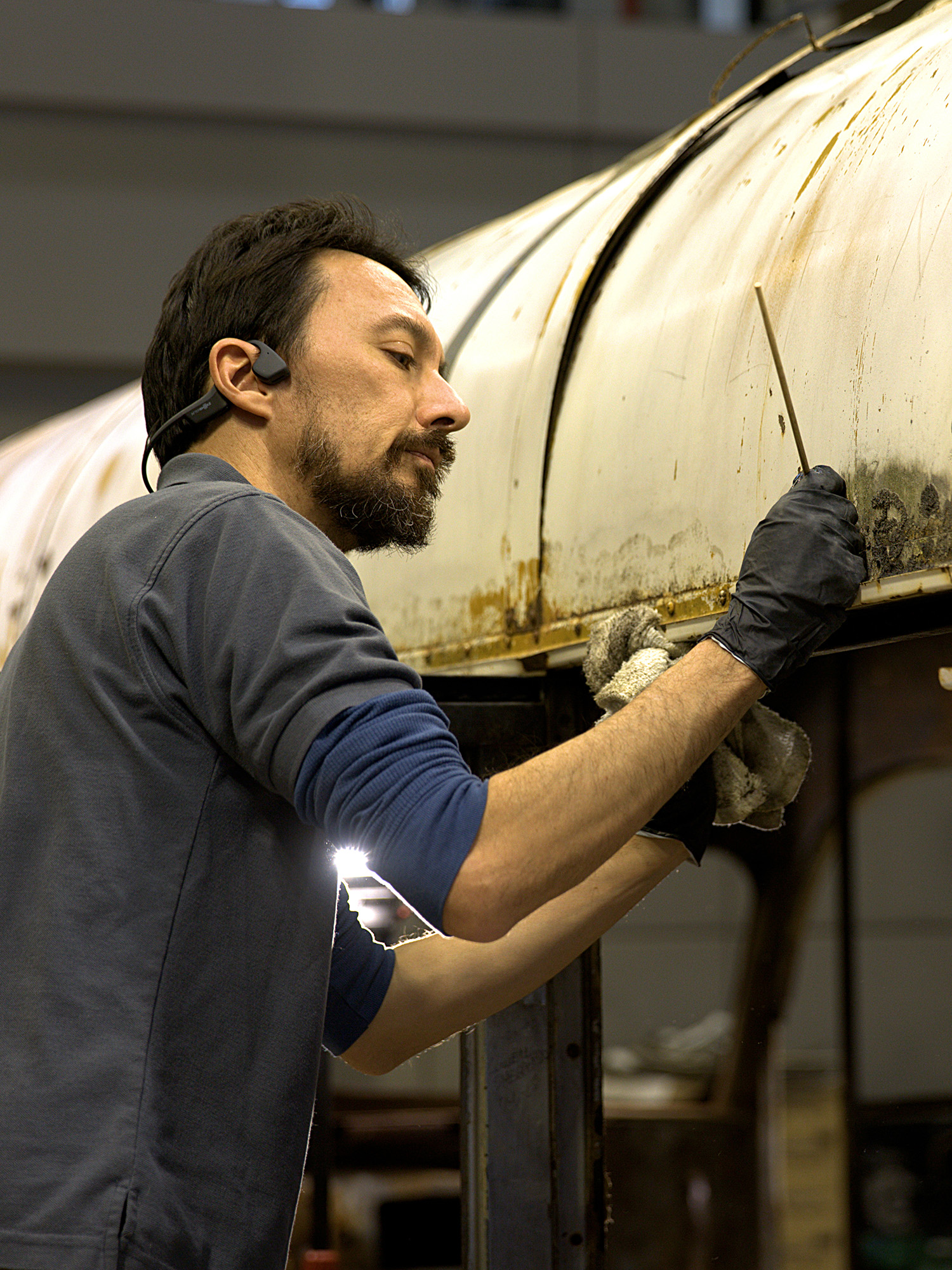
Organic growth
The exterior surface of the bus, due to its 59 year life on the Stampede Trail, had a range of biological products growing on it - mostly lichens and mold. These types of organism are considered “pests” when attached to an object, which is one of the ten agents of deterioration. These are the primary threats to cultural heritage items that museums work against, as they accelerate the natural process of degradation of the items in our care. The lichen already affected the underlying paint by slowly eating away at it, exposing the metal below. Conservators gently removed it with water. |
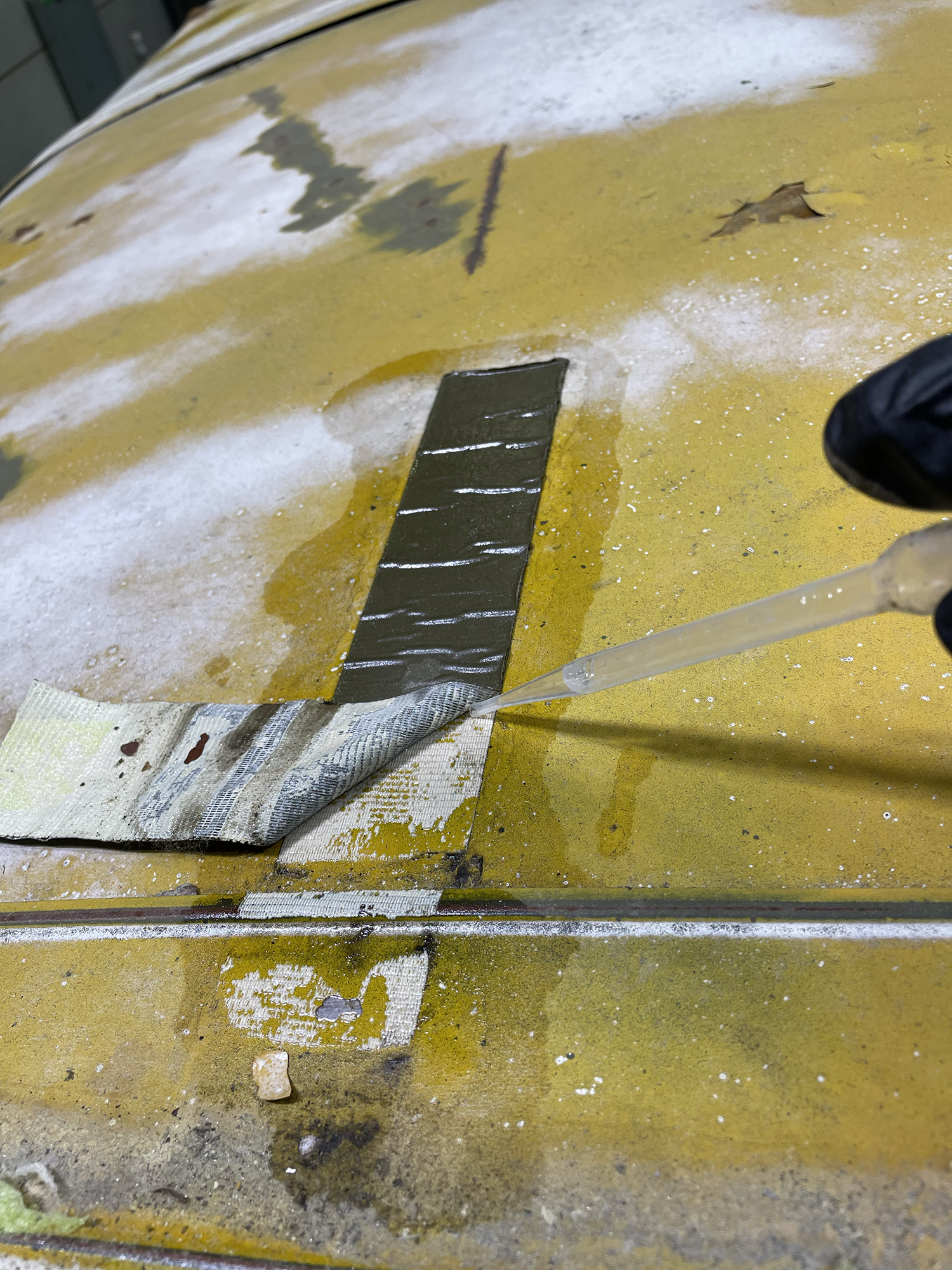
Duct Tape Removal
Duct tape was applied to the bus roof when it was removed from the Stampede Trail by the Army Air National Guard in 2020. The acidic adhesive on the tape is damaging to the surface and paint on the bus. B.R. Howard conservators removed the duct tape using xylene, which easily stripped the adhesive but did not affect the paint. |
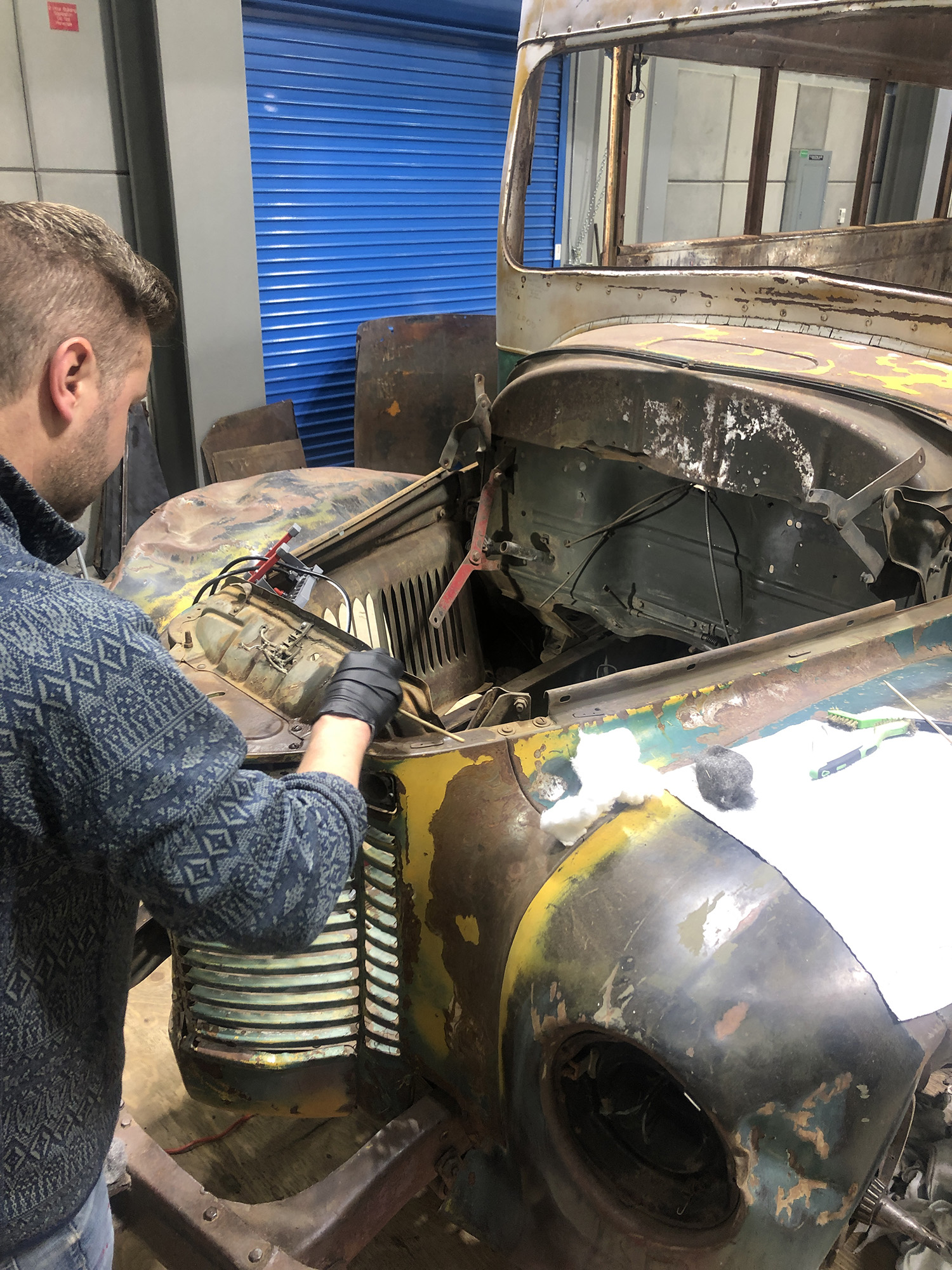
Degreasing
Many visitors ask if the bus was driven out to its location on the Stampede Trail. However, the engine of Bus 142 was removed before being one of two buses that were towed out to the trail by the Mariner family in 1961 to use as housing during the trail improvement project. The engine compartment was used as a covered storage space by dog mushers, trappers, and hunters visiting the bus for decades. The interior walls were coated with dirt and grease, which is highly acidic and corrosive. Conservators from B.R. Howard spent days inside the compartment removing the layers of corrosive residue and adding a protective coating that will slow any further agents of deterioration. |
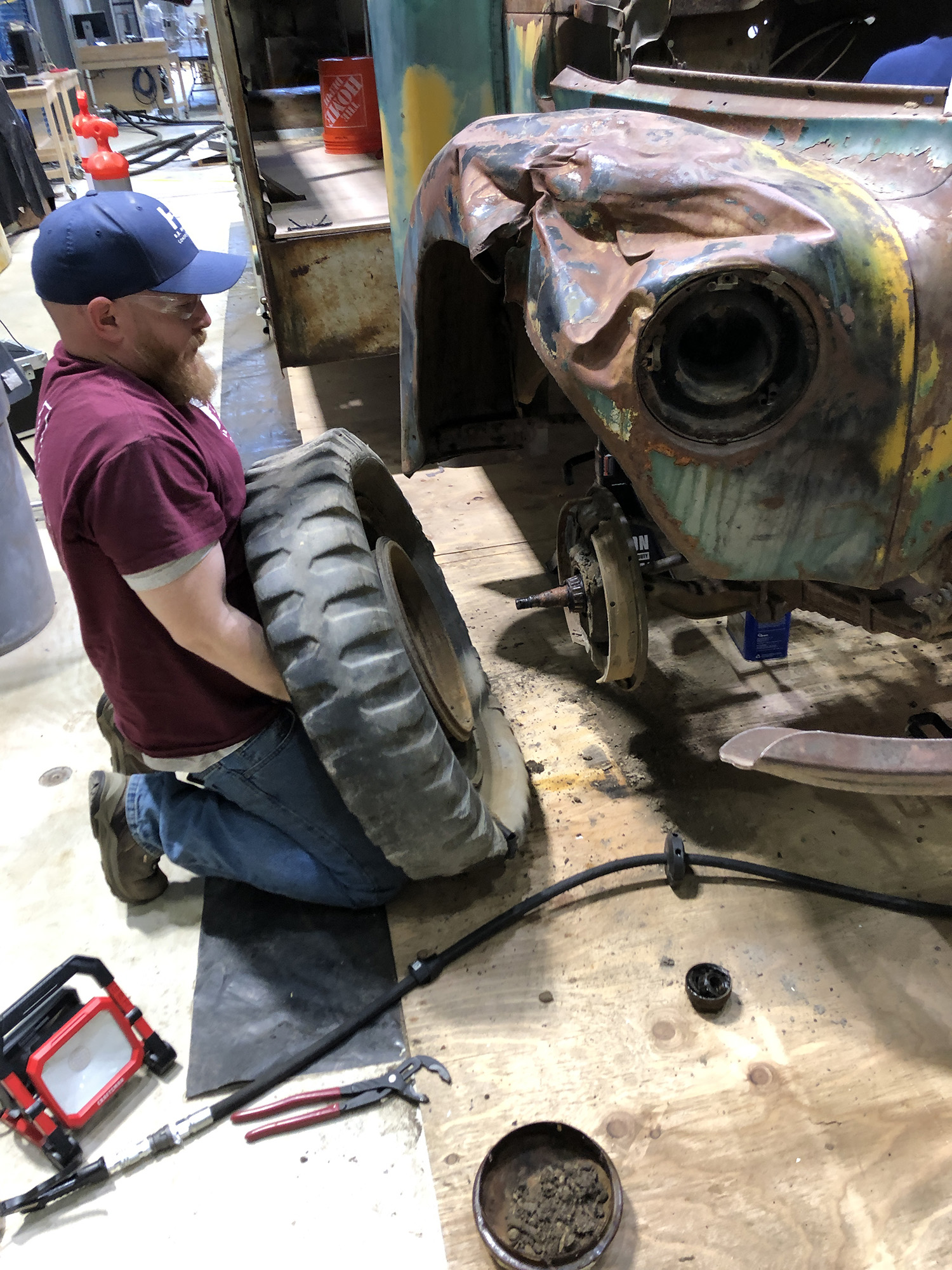
Wheels
The bus wheels are an essential storytelling component for the eventual exhibit. The reason the bus was left on the Stampede Trail was because the front driver side wheel broke away from the hub, preventing the bus from being easily towed back to Fairbanks. After lifting the bus onto jack stands, conservators from B.R. Howard removed the wheels in order to clean the packed dirt from around and inside the hubs. They then applied a protective coating to the metal and painted surfaces. |
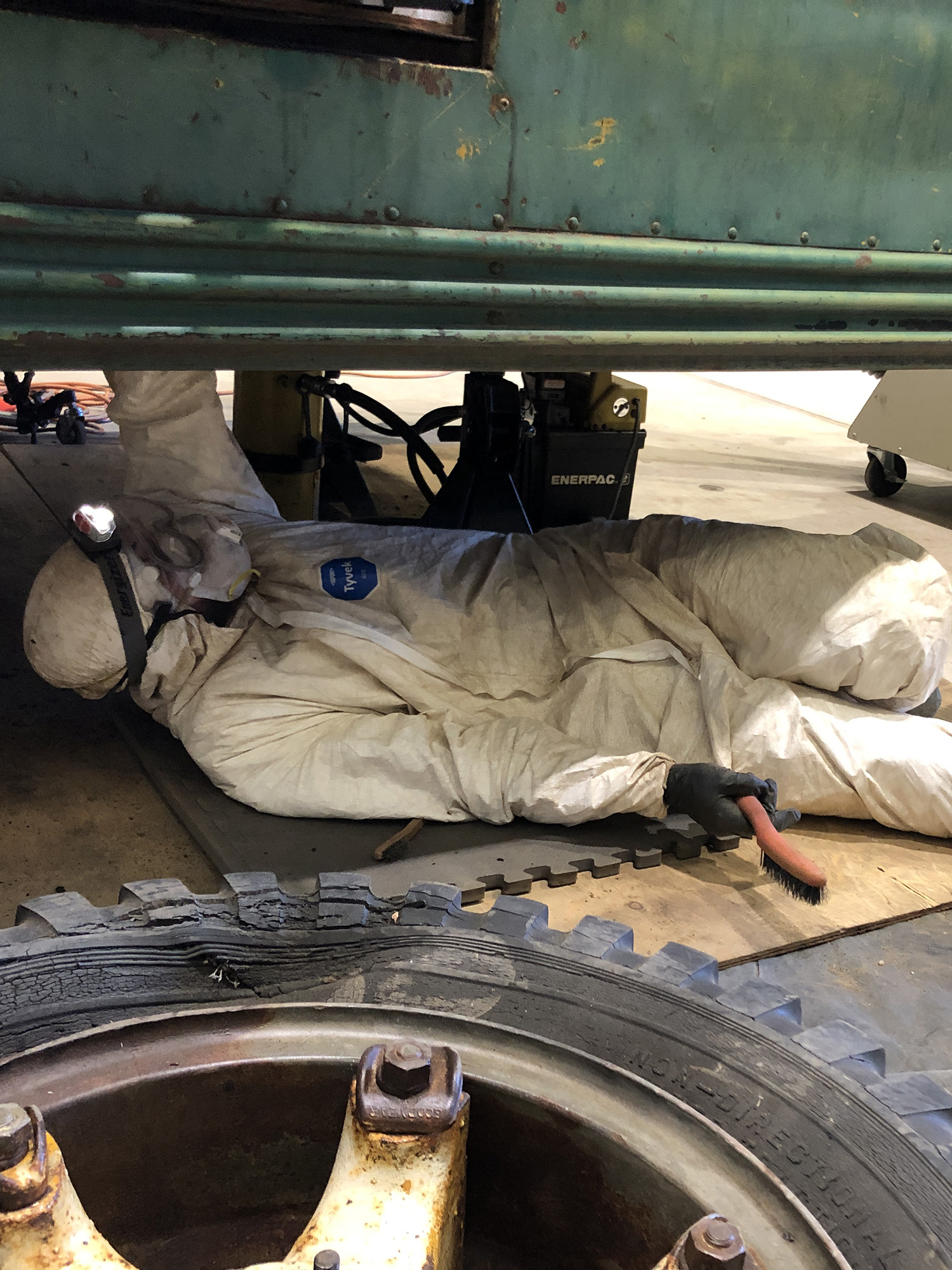
Undercarriage
The bus undercarriage was heavily coated in dirt from the Stampede Trail. Conservators from B.R. Howard spent days scrubbing the undercarriage clean in order to apply a protective coating to slow further rusting of the base structure. |
Stabilizing Floor and Stairs
The interior flooring was fully removed in order to thoroughly stabilize the steel substrate. The first step of the passenger side stairs was completely rotted through, and required replacement and stabilization in order to preserve its appearance and provide safe access to the bus for future generations.
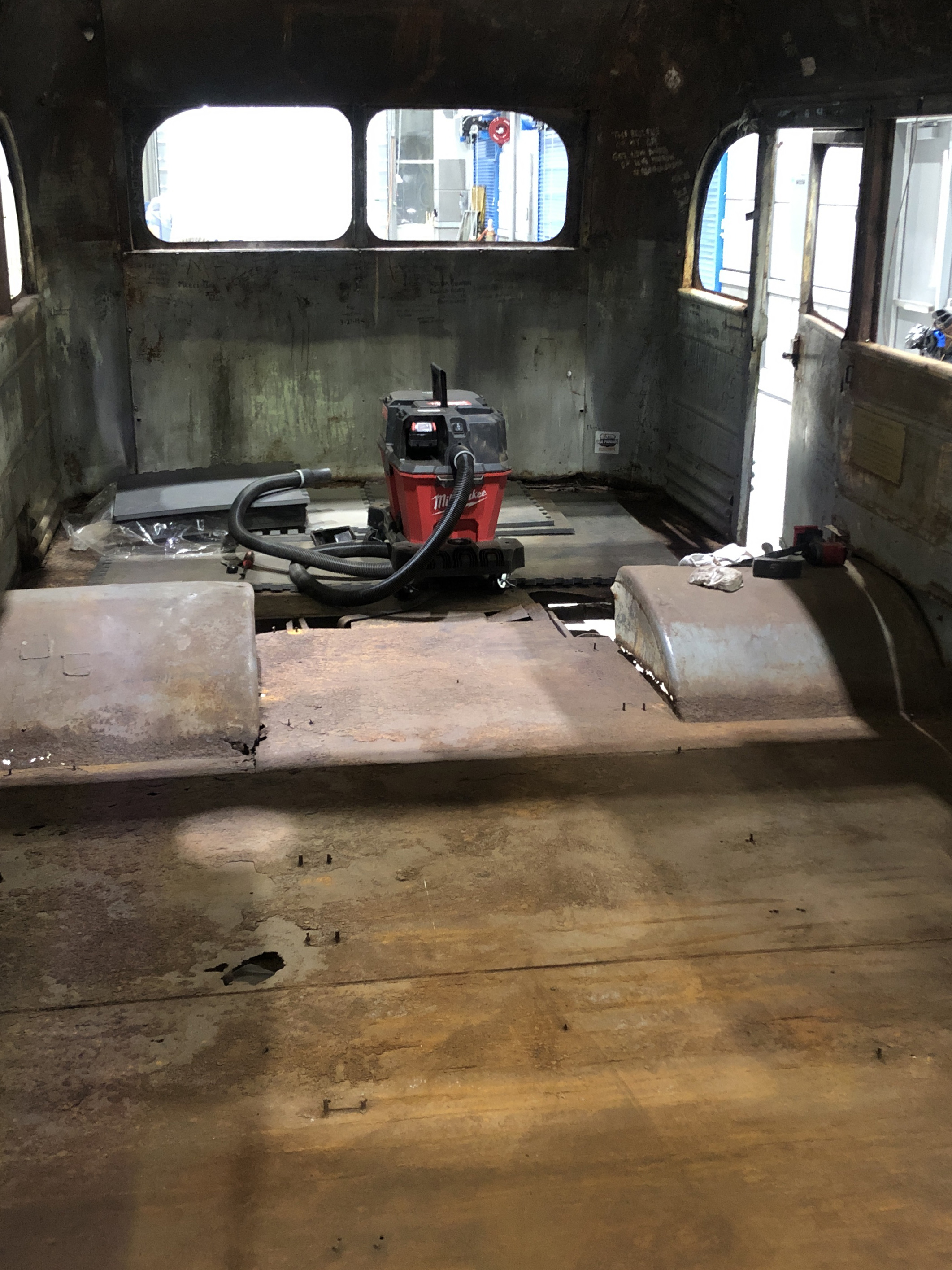
Floor
The bus has a metal structural base layer, which was topped with a layer of plywood that was delaminated from years of exposure to the elements. On top of that was one layer of white vinyl, one layer of red linoleum, and one layer of carpet, all of which were severely crumbling. Unfortunately, none of the layers could be salvaged, so the conservators cut a 1x1-foot section to preserve for historical knowledge, and removed the rest. The metal base layer was very rusted and had many holes and structural issues, which were patched with replacement metal and fiberglass, coated with paraloid B-48N to prevent further rusting. A layer of tar paper serves as a vapor barrier, over which they laid down new plywood for strength, followed by new linoleum to match the original flooring. This provides the structural stability necessary for future visitors to the bus. |
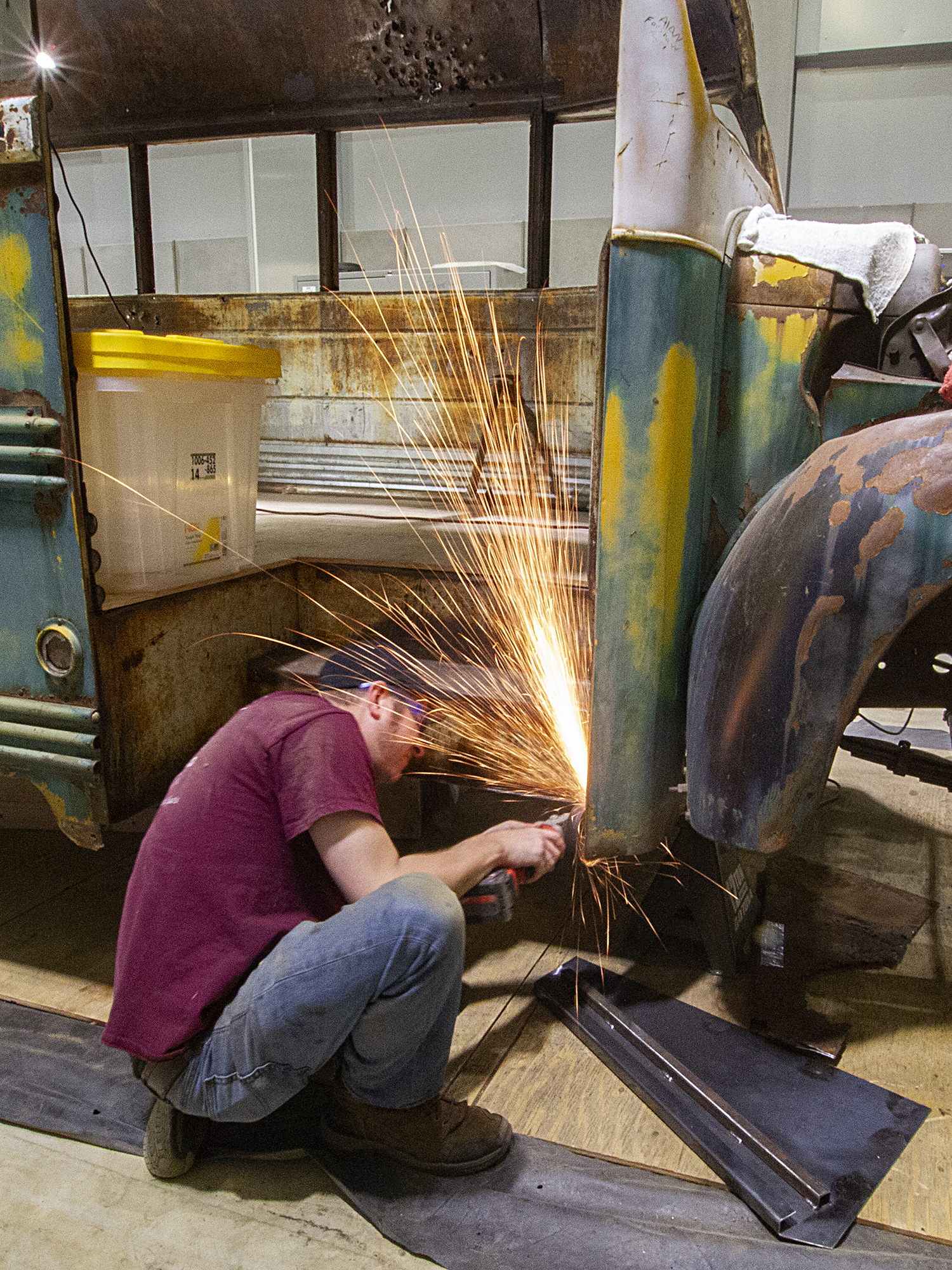
Stairs
As a result of years of use and precipitation, the bottom entry step was heavily damaged and had a large hole. The step was constructed of two layers: a base of steel and a textured tread plate. For safety, the step was removed and a replica of the steel base was fabricated by Facilities Services and installed by the conservation team. The original tread plate was repaired with fiberglass and reinstalled on top of the new stabilized step, preserving the original appearance of the step while ensuring safety and stability for future visitors. The original steel base step was cataloged into the museum collection. |
Replacing and Repairing Windows and Doors
The doors were repaired and all seals and windows were fully replaced in order to close up the bus and prevent precipitation and animals from infiltrating, as well as reducing the possibility of additional vandalism.
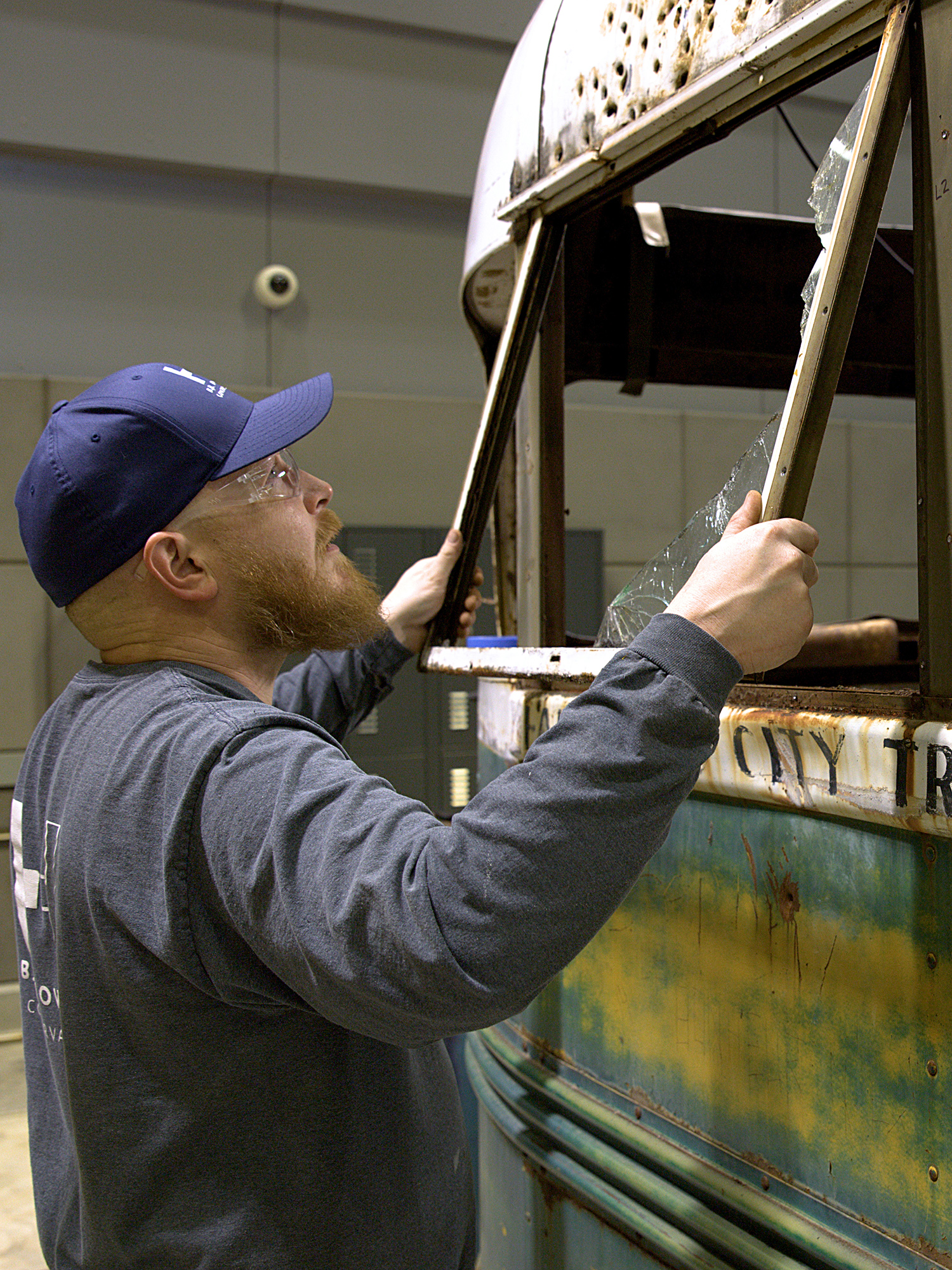
Windows
The majority of the windows were either broken out or severely cracked prior to arriving at UAMN. The window frames were taken out, each requiring the removal of 12 screws. The glass was replaced into the original frames through a generous donation from Frontier Glass. This encloses and protects the bus interior from further deterioration. |
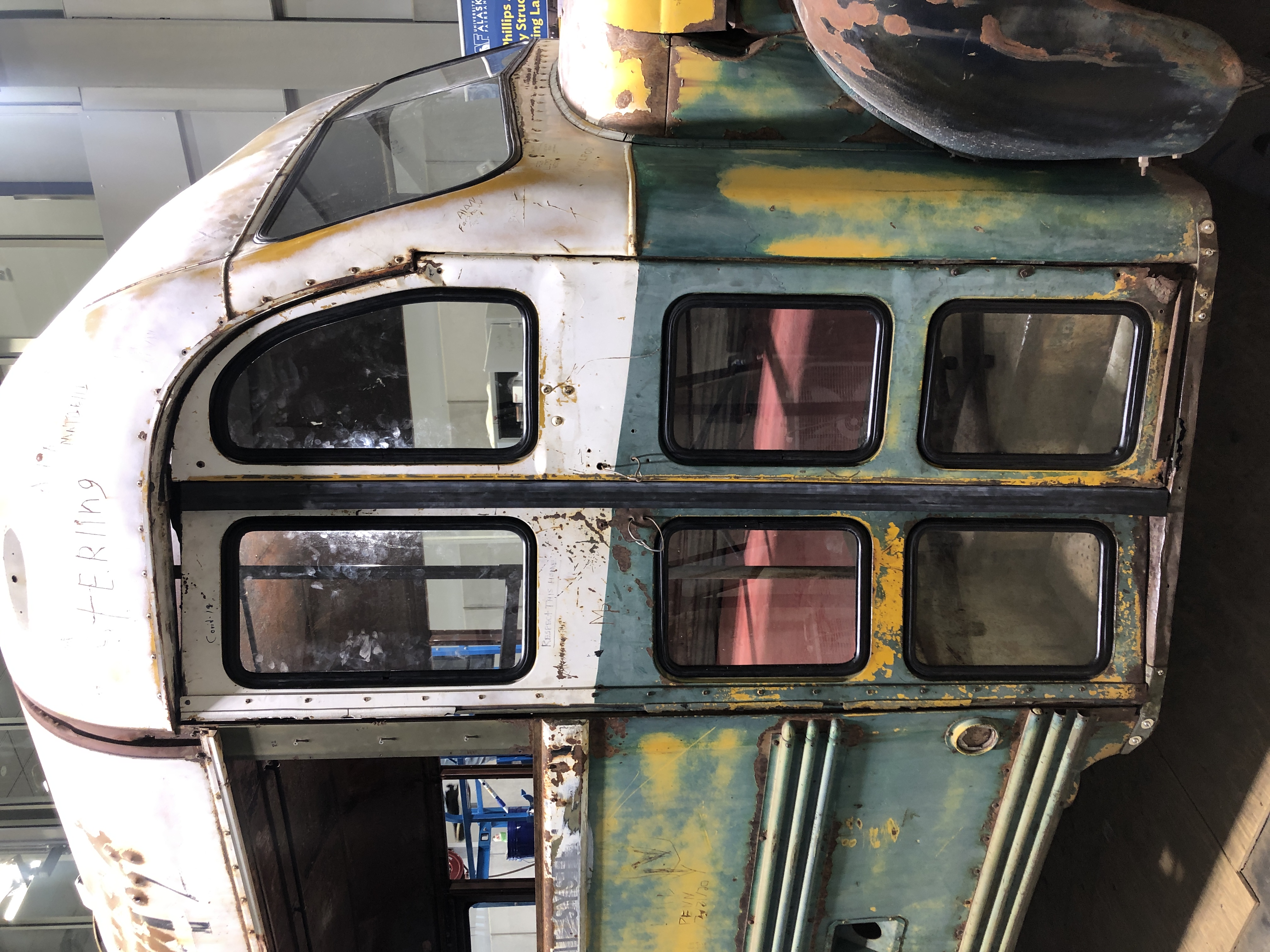
Passenger Door
The passenger side doors were severely damaged from use and prior attempted repairs to the mechanism, in addition to missing and broken glass and rust. After the donated glass from Frontier Glass was installed, the conservators repaired the hinges so the doors can fully open and close, sealing the bus from further precipitation and pest damage. |
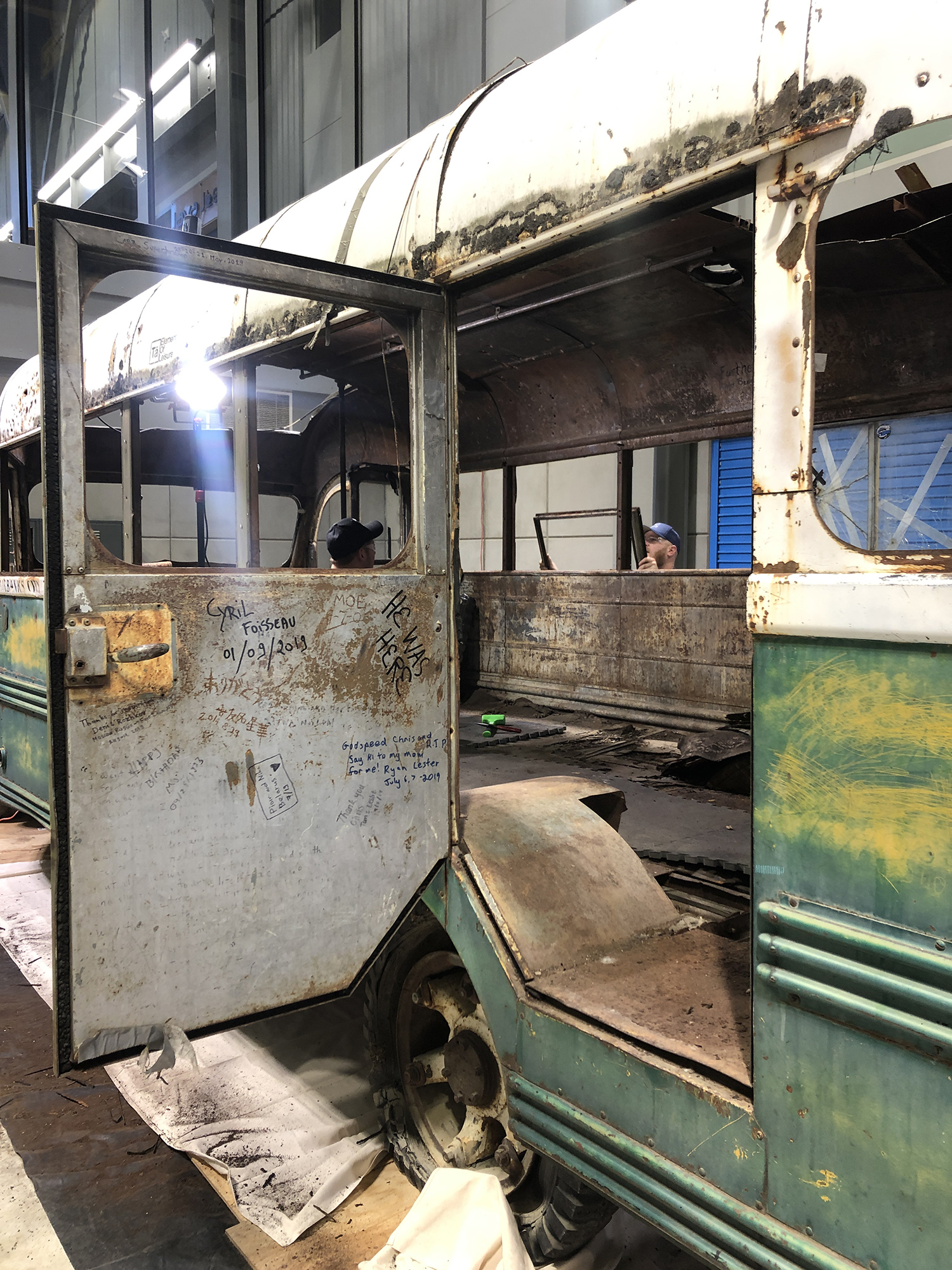
Rear Door
The seal of the rear door of the bus was completely rotted and prevented the door from fully closing. The conservators replaced the seal to keep out precipitation and allow the door to close, which will additionally prevent further pest damage. |
Sealing up Holes
Bullet holes were softened by slightly filing, flattening, or deburring the edges. Some infilling and covering helped to match adjacent surfaces and prevent continued damage from precipitation and pests. This was especially important for the iconic “142” area stenciled above the driver side window, which was heavily damaged by bullet holes.
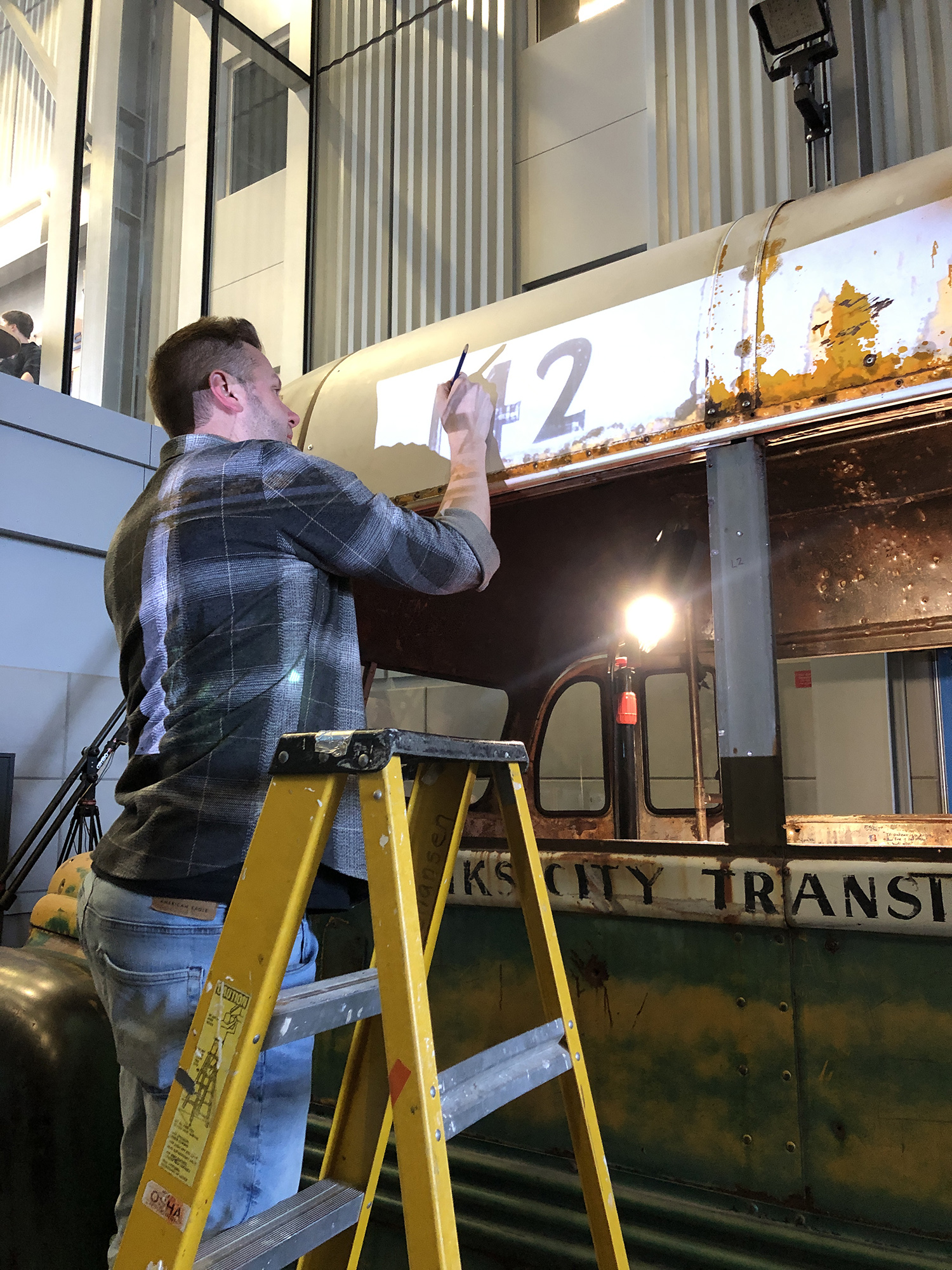
Driver Side 142
The iconic 142 painted on the driver side of the bus was severely damaged from
gun shots and years of precipitation on the Stampede Trail. In order to seal up the
bus from pests and further rusting a layer of sheet metal was placed over the area,
covering the damage on the outside while allowing the holes to remain visible on the
inside. The conservators repainted the 142 using reference photos prior to the sustained
damage.
|
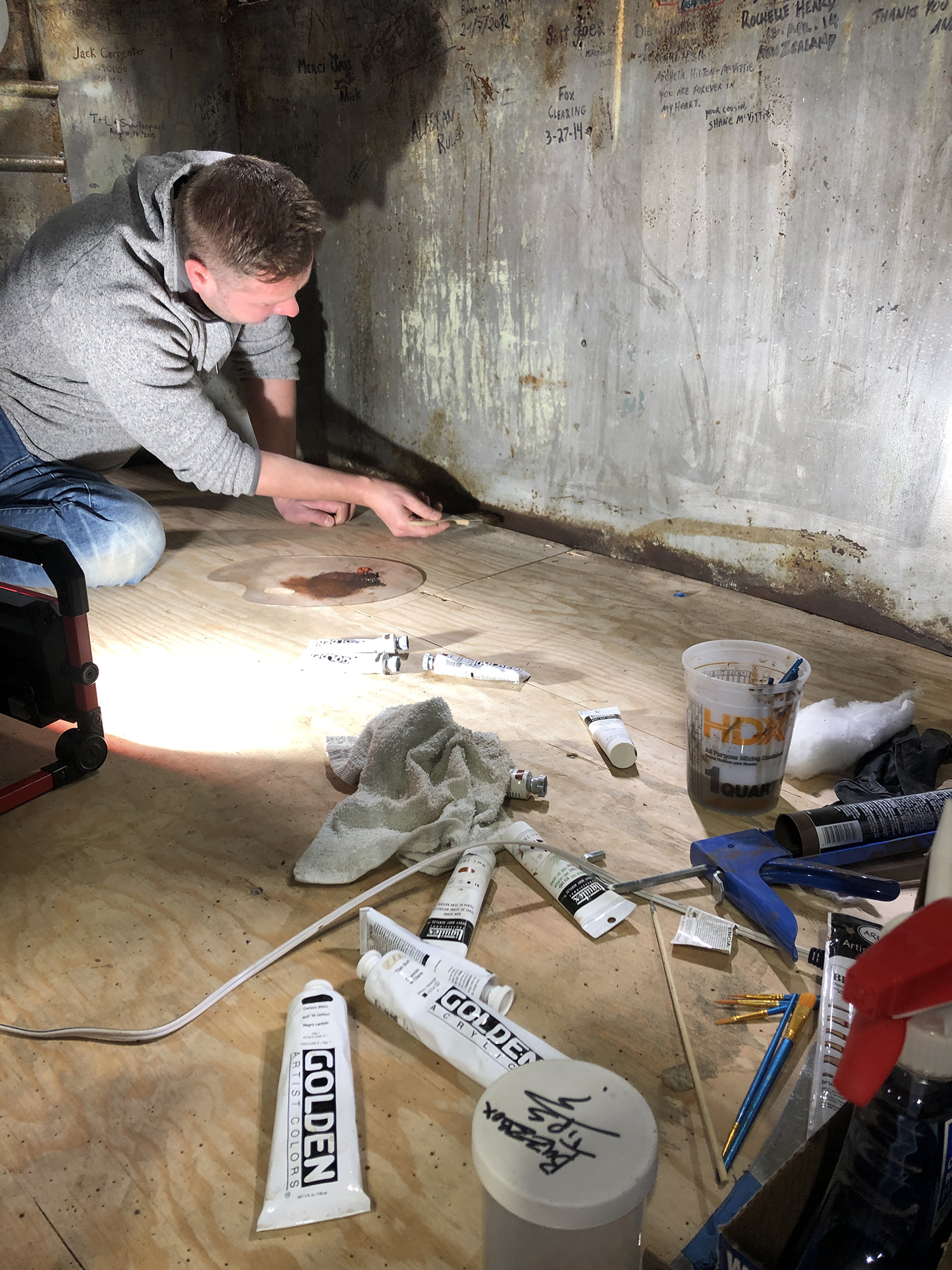
Rear Wall
The rear wall of the bus has a significant amount of graffiti that was important to protect against current and future agents of deterioration. This same wall had extensive water damage along the bottom and had rusted away an inch or two of the metal. In order to fully seal up the bus to reduce further weather deterioration and pests (two of the ten agents of deterioration), the bottom portion of the wall was recreated using fiberglass. The entire panel, which has years of graffiti from travelers, was then coated with a protective layer to slow further losses. The fiberglass was painted to match the surroundings once re-installed. |
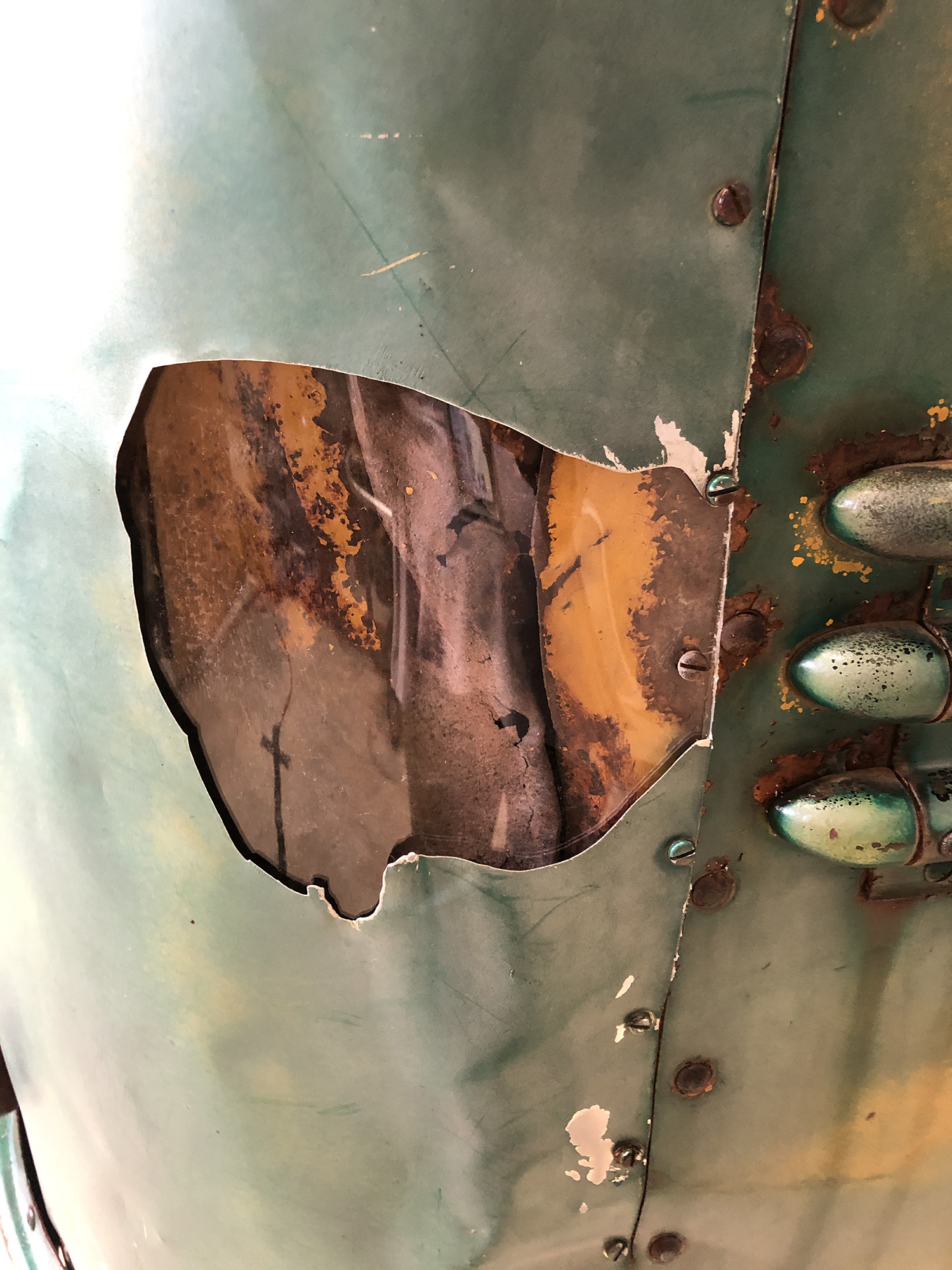
Holes
Bus 142 had many holes from gunshots, rust, and vandalism. These holes allowed agents of deterioration, such as precipitation and pests, to increase the speed at which the bus was deteriorating. To slow this process, the conservators sealed all holes using a variety of methods. These included applying a plexiglass cover, spray foam, metal, fiberglass, and caulk, as appropriate. |
Repairing and Replacing Structural Components
When Bus 142 was removed by helicopter from the Stampede Trail by the Army Air National Guard, holes were cut in the floor and roof in order to attach to the chassis. These holes were repaired by the conservators by reattaching the original components.
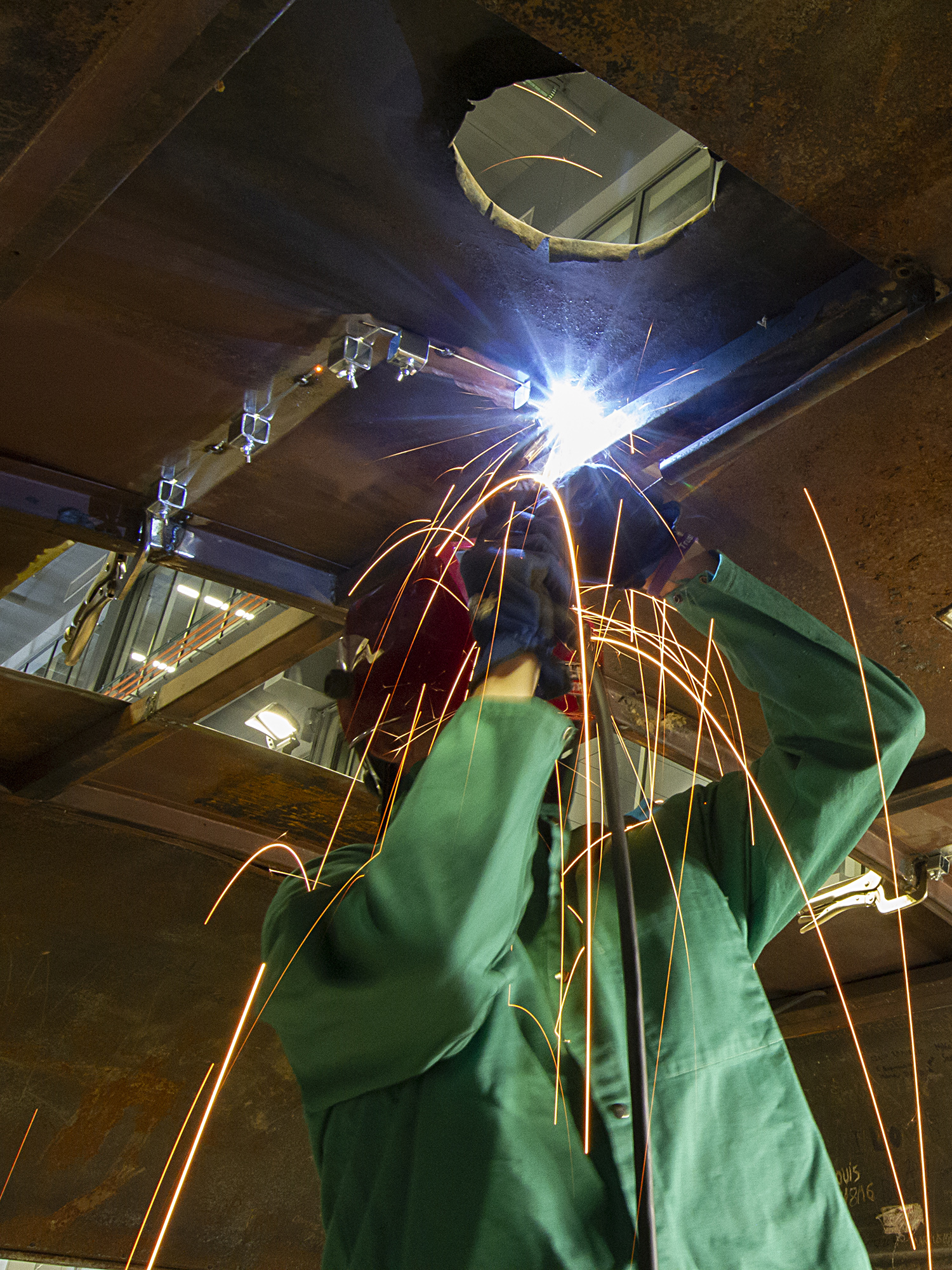
Roof
The Army Air National Guard cut large holes in the roof and floor in order to safely support the frame of Bus 142 when flying it out of the Stampede Trail via helicopter. Conservation team B.R. Howard reattached the roof panels by welding or using screws as appropriate, taking care not to obscure any of the graffiti, which was preserved. |
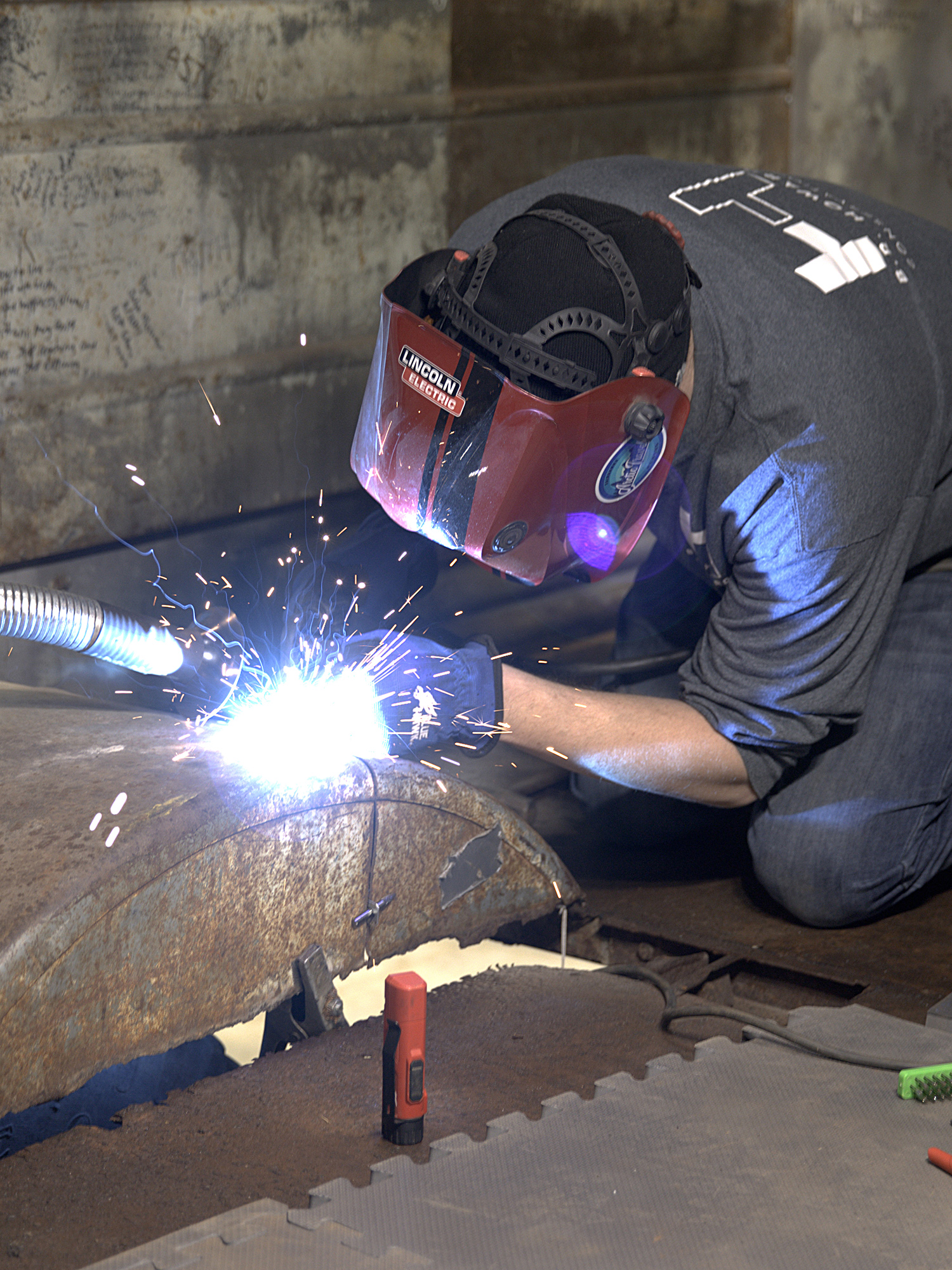
Wheel Wells
The wheel wells were partially cut away when the Army Air National Guard removed the bus from the Stampede Trail in 2020. Conservators from B.R. Howard welded these pieces back on to restore the visual appearance and retain the graffiti. While the major goal of conservation remains preservation, it is necessary to refit this component of the bus to enclose and protect the interior. Even though this re-attachment of the original component is technically not reversible like most conservation work, the visual continuity was maintained. The conservators painted the welded seam so it blends in with the overall appearance. |
Additional Objects
The smaller items that make up the rest of the Bus 142 collection have been subject to minimal surface cleaning and have been nearly completely cataloged, photographed, and housed in archival custom-made boxes, which can be viewed in our database Arctos. The wood stove and bed frames were vacuumed, excess rust build up was brushed, and a protective consolidant coating was applied.
Loose and detached components were secured with custom fabricated mounts, particularly, the holes cut in the roof and floor that occured during its removal from the field as well as repairing the pipe of the barrel stove and entry steps. Remediation through attached mounts was determined through consultation with the interpretive advisory team.
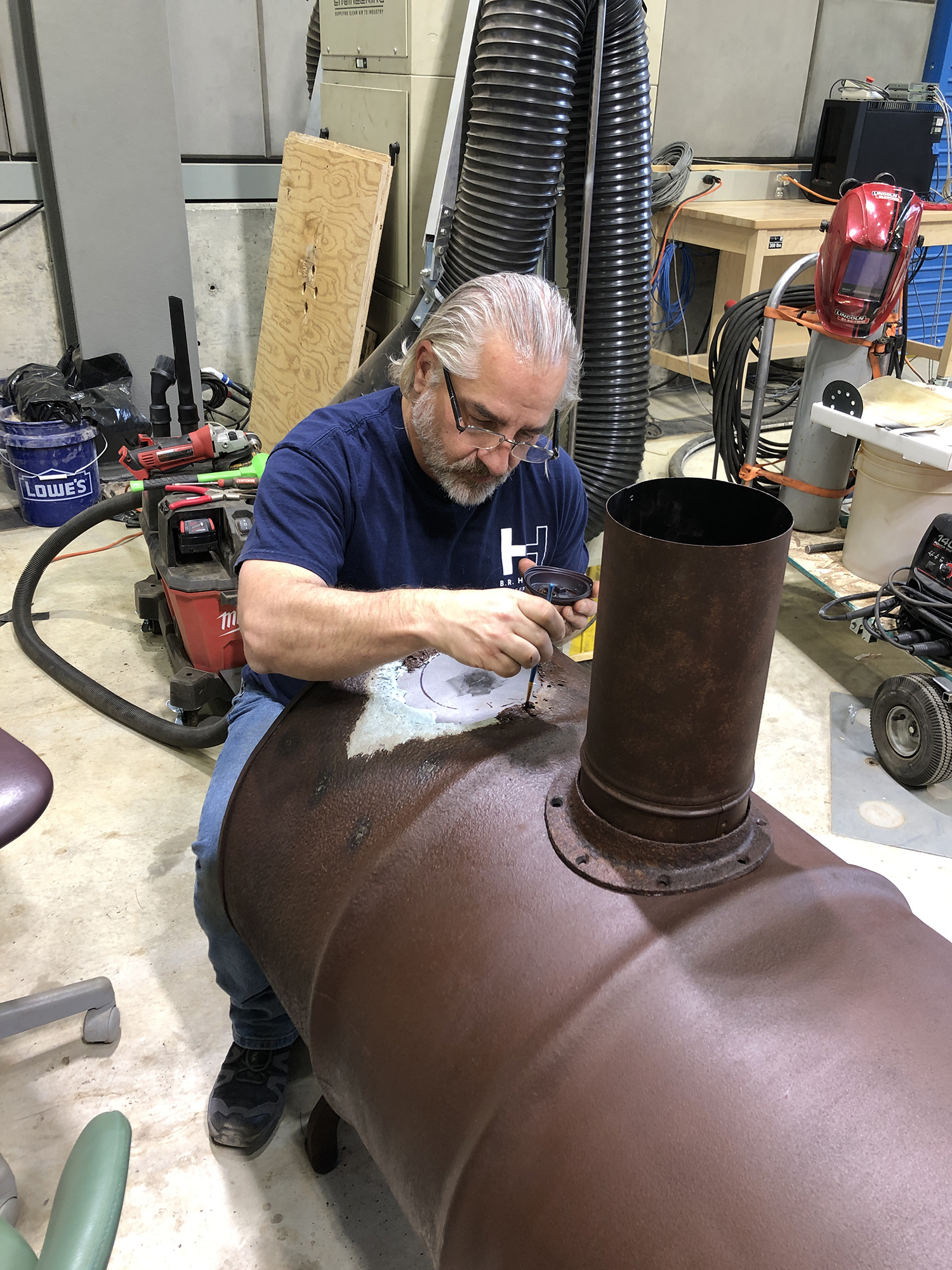
Wood Stove
The wood stove was heavily rusted and would continue to deteriorate if not addressed by conservation team B.R. Howard. After the conservators sifted through the contents of the stove, a museum student curatorial assistant and project manager brushed the surface to prepare for the application of a protective layer of consolidant, to slow the rusting process. Conservators also replaced the rusted out stove pipe and re-attached the cap outside, repairing the hole for structural stability and to keep out further agents of deterioration, such as pests and moisture. The stove was placed back inside the bus where it was originally located. |
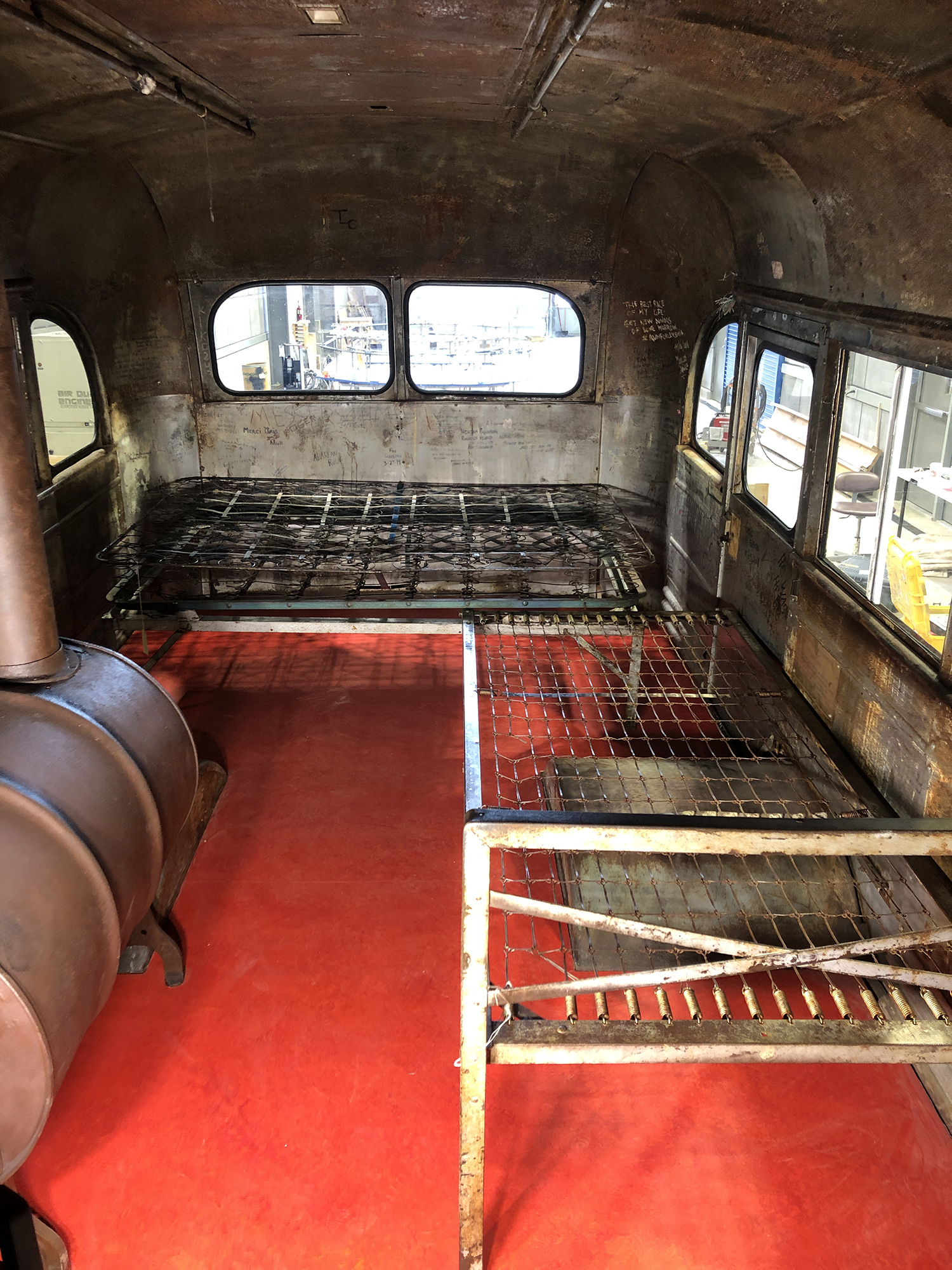
Beds
The two beds inside Bus 142 consist of a full-size bed frame, box spring, and mattress, as well as a twin size bed frame with springs. The bed frames and box spring were vacuumed to remove excess dirt and fibers, and were sprayed with a protective coating to slow further flaking of the paint and rusting of the metal. The full-size mattress was heavily soiled and had sustained extensive damage from insects and pests after decades on the Stampede Trail. To prevent further damage, it has been stored in the museum collection. |
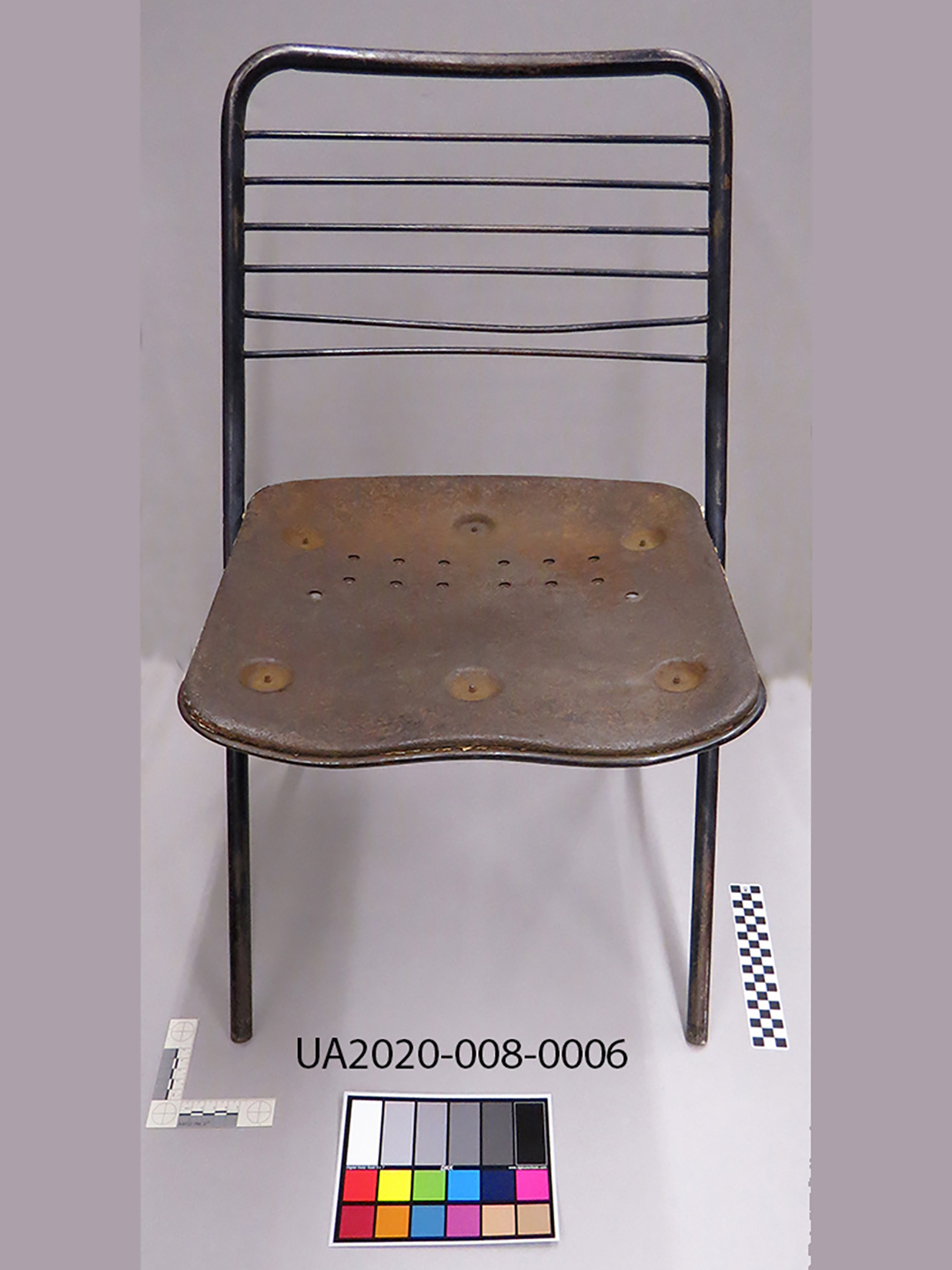
Cataloging
Bus 142 came with over 200 items inside, all of which are being cataloged into the Ethnology & History collection. Catalog records can be viewed in our Arctos database. |
Corrosion Stabilizers and Protective Coatings
Conservators managed and reduced the active corrosion using hand tools. Appropriate treatments were determined to include Paraloid B-48N and B-72.
Internal and external paint layers were consolidated and stabilized using reversible materials to prevent further flaking, tenting, and additional losses. A clear non-yellowing consolidant Paraloid B-72 was used. Because the graffiti on the surface is considered a significant component of the story and history of the bus, all treatment options were adjusted and modified so as to prevent damage and not limit the legibility.
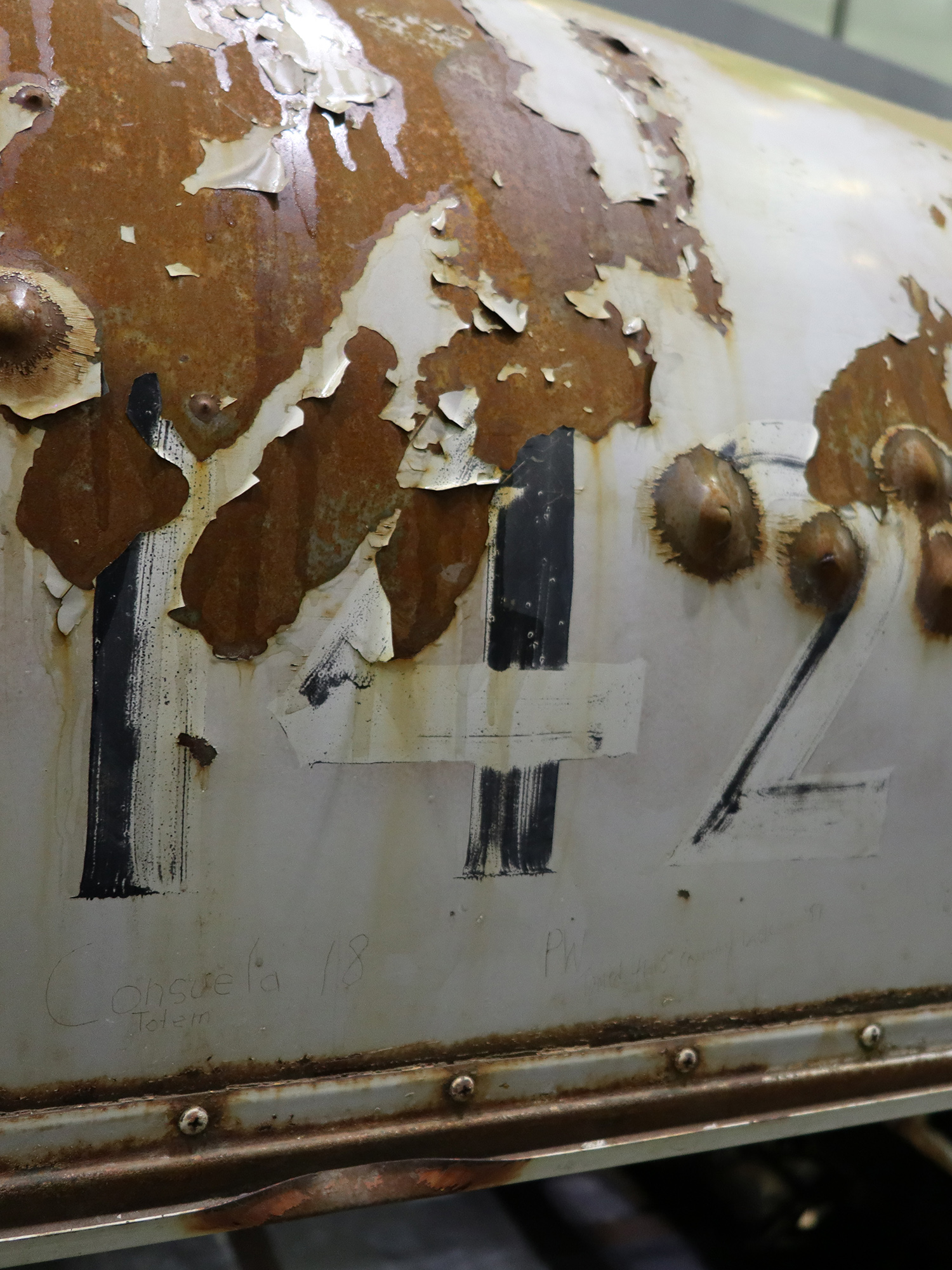
Peeled Paint
The exterior surface of the bus was painted in three layers: a base layer of Army green, followed by school bus yellow, and a top layer of bright green and white for the Fairbanks City Transit System. Due to years of exposure on the Stampede Trail, graffiti, and bullet holes, the paint was peeling and flaking in many areas, resulting in losses. The conservators used Paraloid B-72 and a tacking iron to readhere large paint flakes and coated the entire surface to prevent further peeling. |
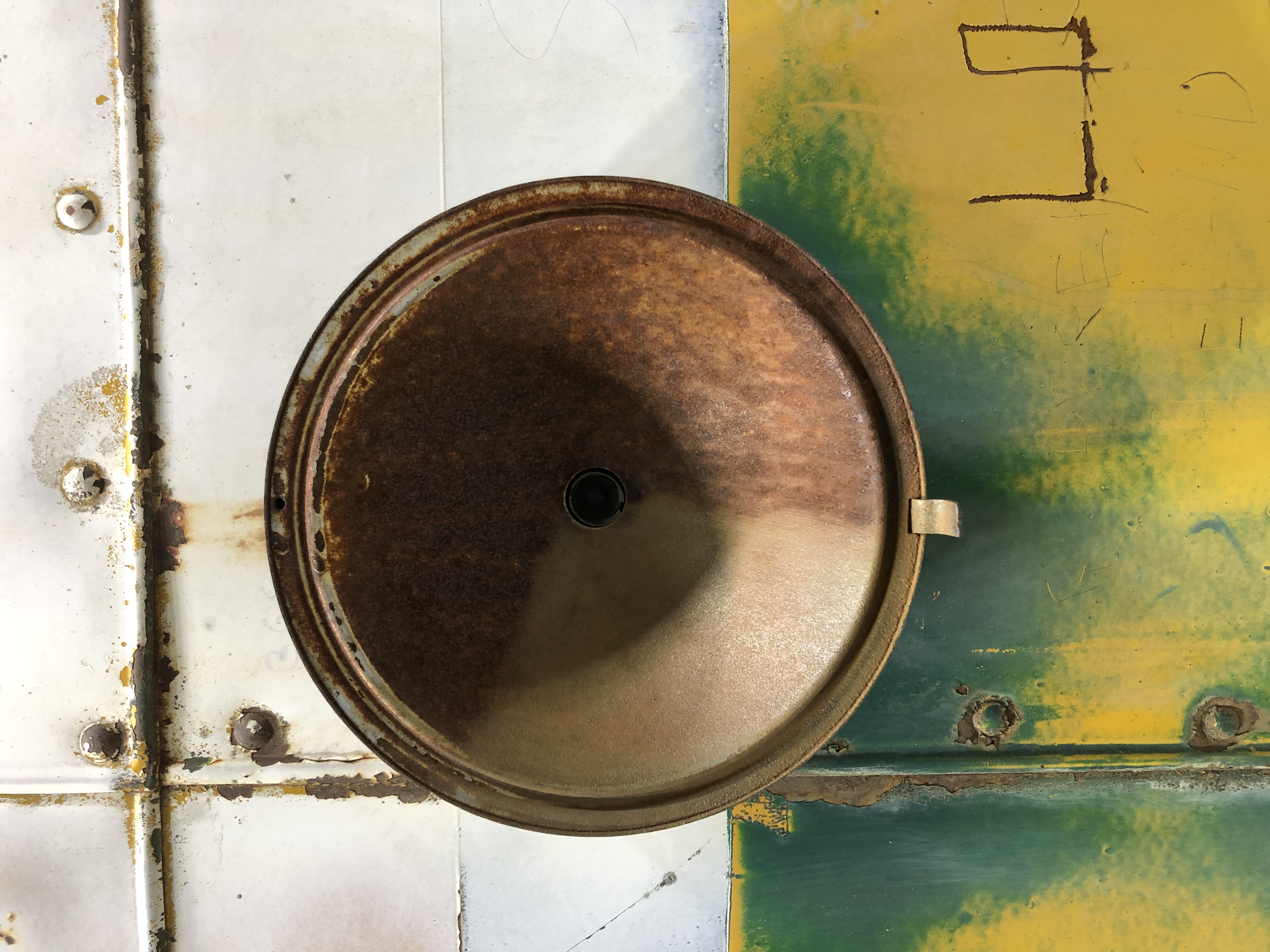
Rust
Many areas of Bus 142 were heavily rusted from years of exposure on the Stampede Trail. In order to treat the rust, the conservators scrubbed the surface using a variety of hand tools, removing the topmost layer of iron oxide powder so that a protective coating of Acryloid B-48N could be applied to slow the oxidation process and preserve the metal beneath. |
Long-term Monitoring and Care Guidelines
The long-term care of Bus 142 is of great importance to our curatorial team and essential to the ongoing viability of the outdoor exhibit. The conservators will provide a set of long-term monitoring guidelines. Weekly, monthly, bi-annual, and annual condition surveys will be scheduled into our workload to monitor treatments and repairs and determine whether some treatments might be repeated.
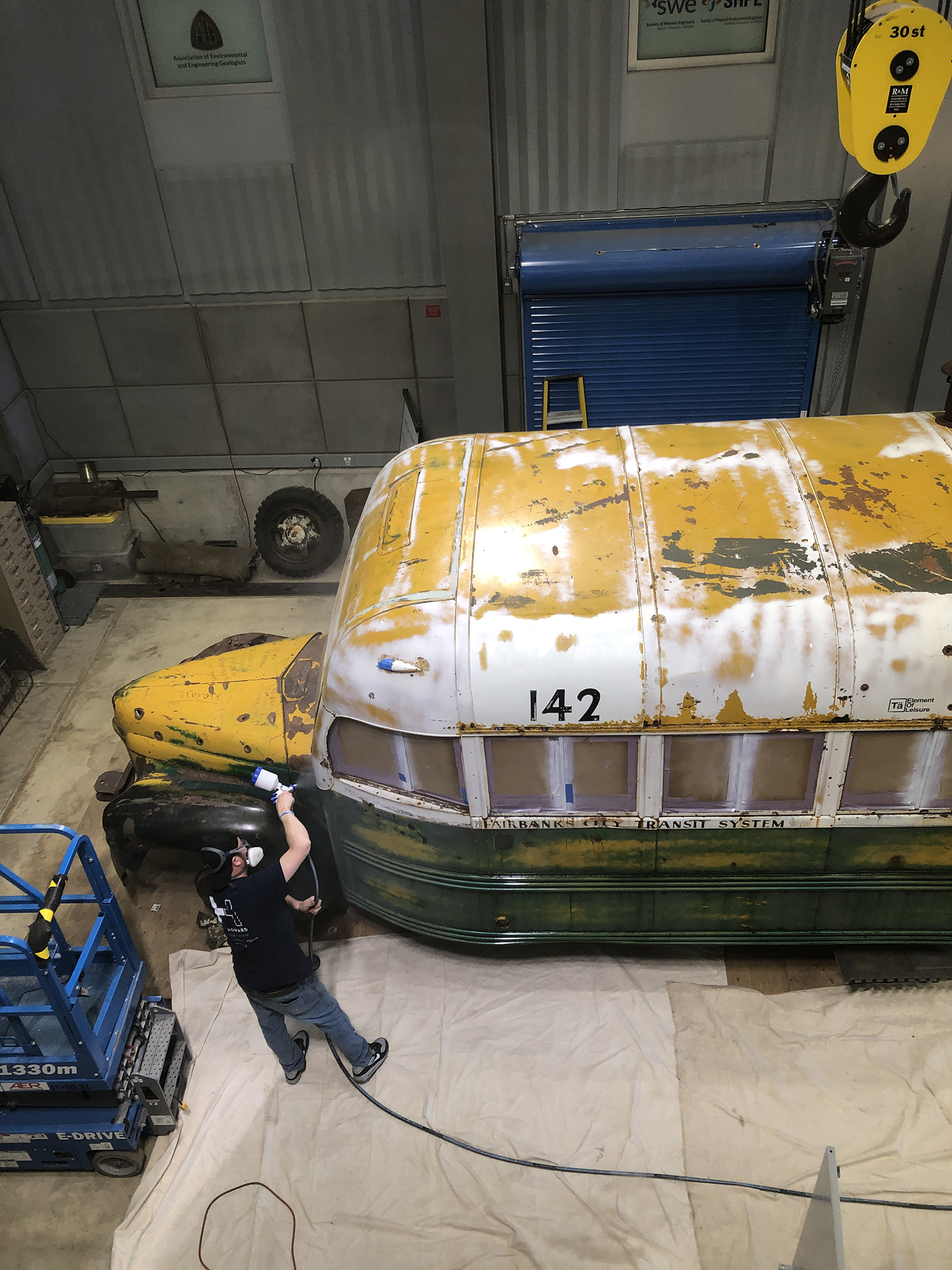
Consolidant
Since Bus 142 will be exhibited outdoors, the protective coating applied by B.R.
Howard will be monitored and assessed following ongoing care guidelines established
in their conservation treatment plan.
|
Training UAF Students
Training UAF students in collections care and material science was a complimentary goal of this project. Students assisted the conservators and Project Manager in documentation, hands-on stabilization, and cataloging of the Bus 142 collection.
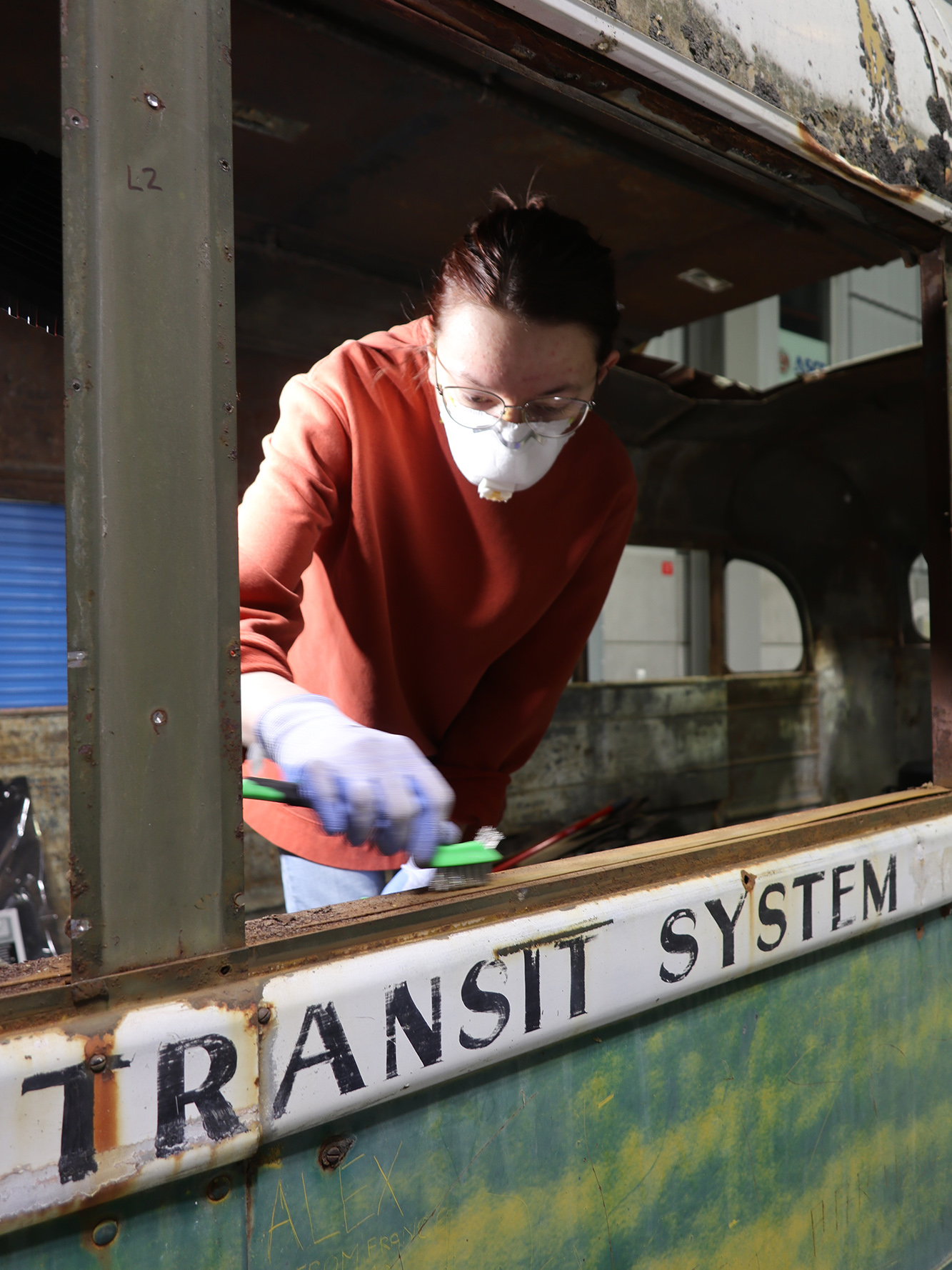
Student Training
Two Student Curatorial Assistants, Brooke Fisher and Hannah Witherington, assisted with hands-on conservation treatment work and cataloging collection items into the Arctos database. |

